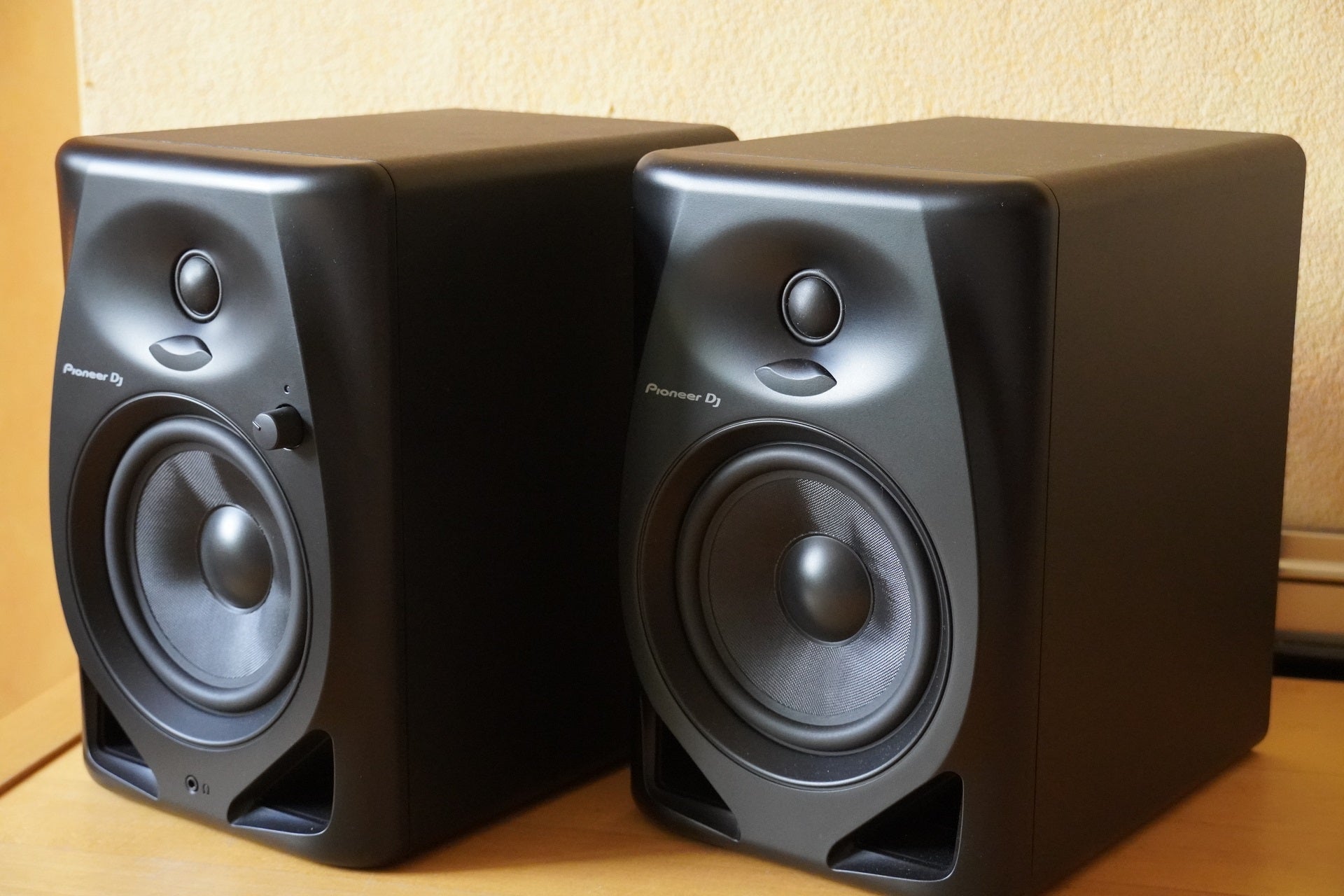Verdict
An active monitor speaker for budding DJs and music producers, the DM-50Ds feature a clever EQ switch, compact design and good reproduction of music, especially in their Production mode. If you’re in need of more bass extension or wireless connectivity, there are other, likely more expensive options, available elsewhere.
Pros
- Switchable EQ modes
- Range of connectivity options
- Good sound from both modes
- Compact design
- Affordable
Cons
- Not suited for bass-heavy productions
- Wireless version is available
Availability
- UKRRP: £199
- USARRP: $199
- EuropeTBC
- CanadaRRP: CA$199
- AustraliaTBC
-
EQ switchChange between sound for warmer DJ presentation or neutral tone for music production on-the-fly -
Class D amplifierFeatures a 96kHz sampling digital signal processor -
Two-way bass reflex speaker3/4-inch tweeter and 5-inch woofer
Introduction
In recent years, the Pioneer brand has been missing from UK stores for a variety of reasons. However, the Pioneer DJ sub-brand is still alive and kicking, even if it’s actually owned by a different parent company (Yokohama-based AlphaTheta).
It perhaps shows that in terms of recognition, the Pioneer name still carries some weight, and the DJ slice of the brand focuses on music production and professional sound systems such as DJ controllers and sound mixers.
The product we have in for review is the DM-50D, a pair of active monitor speakers that can switch between DJ and Production modes to fit your workflow. At £199 they’re an affordable set of speakers for novice producers and budding DJs looking to get into the music production.
Design
- Neat, compact design
- Active speaker approach
- Range of connectivity options
The Pioneer DM-50D come in black or white finishes, and their small and compact form makes it easy to sit them on a desktop surface with dimensions of 262 x 175 247mm (HWD) – note that the left speaker is slightly deeper by 10mm (257mm). With the left speaker weighing 3.9kg and 3.5kg for the right, they’re not too heavy to cart about either.
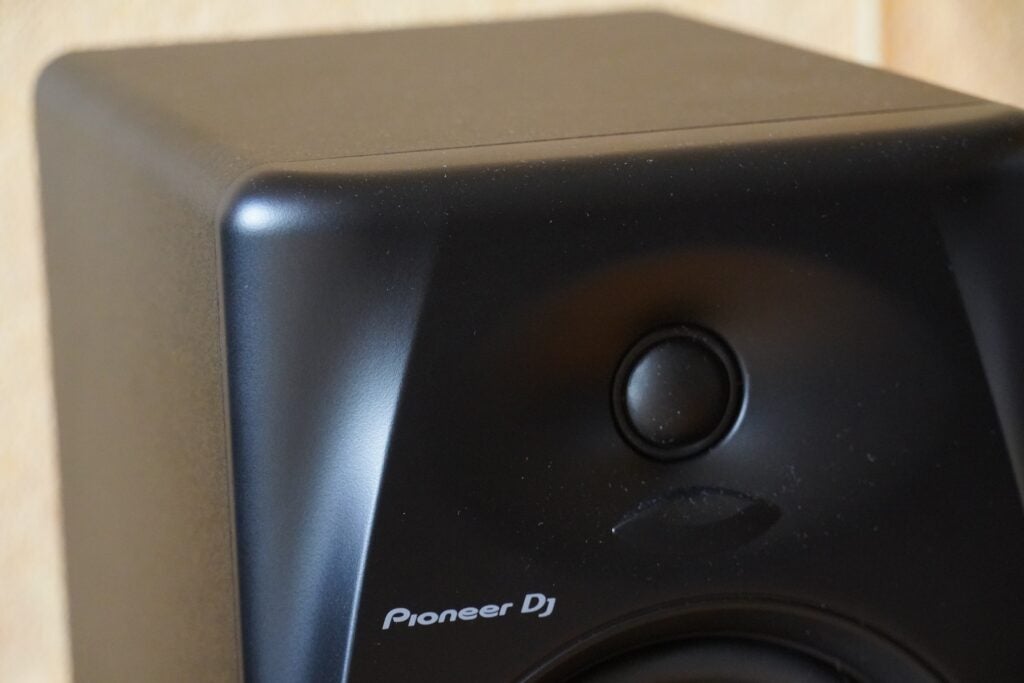
Build construction is solid. The DM-50D use MDF vinyl laminate material for their cabinet, and a few knocks on the top and side give the reassuring impression of rigidity and inertness. The left speaker forms the active part of the system, featuring a built-in amplifier that removes the need for an external unit. The left speaker is also where the connections can be found, with a headphone output on the front and a 3.5mm stereo mini-jack, TRS jack and RCA connection on the back.
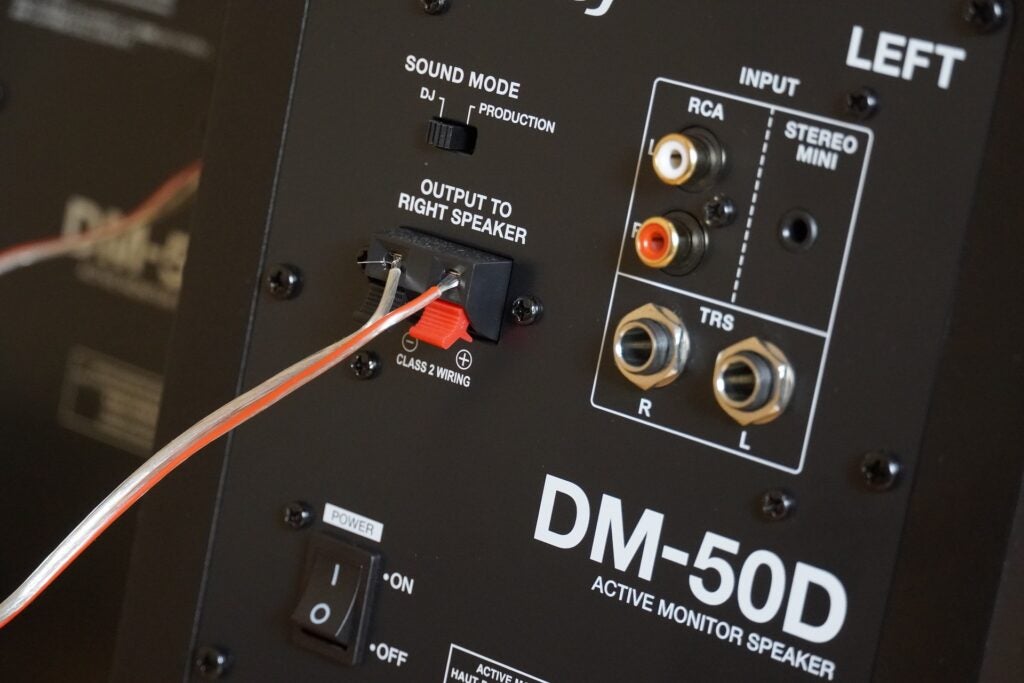
There’s also a terminal for connecting the two speakers by a thin speaker wire (for the wireless version of these speakers, look for the DM-50D-BT online), and there’s also a switch for power alongside another for flicking between the DJ and Production modes.
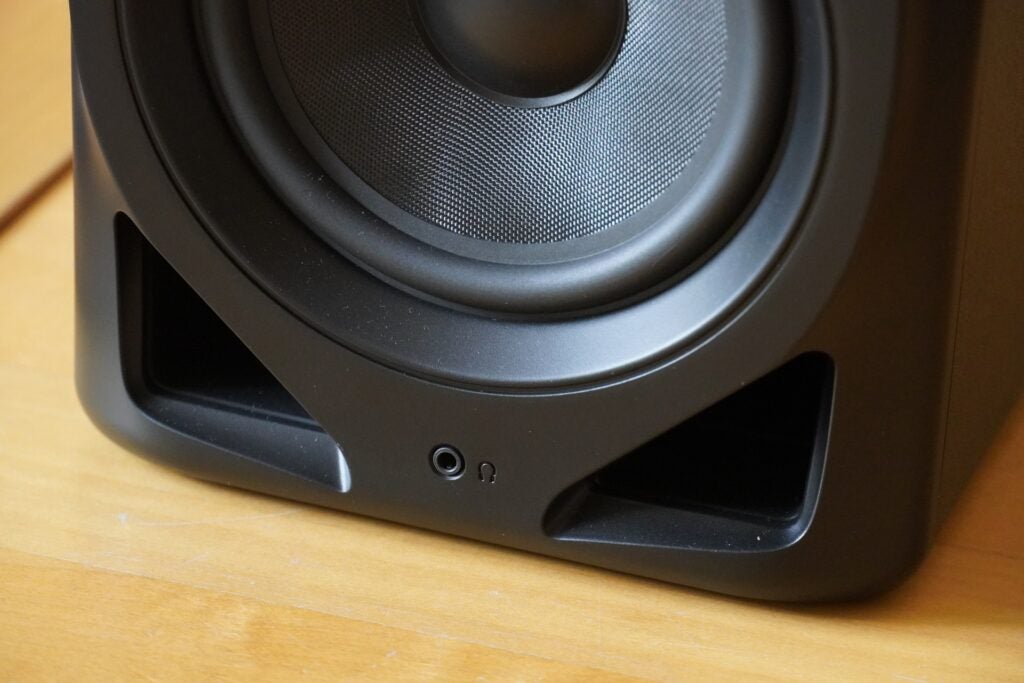
Back to the front and you’ll find volume control just above the woofer on the left speaker, while towards the bottom are grooved ducts on each speaker. These intend to reduce air friction for tight and punchy bass, even when the speakers are positioned next to a wall. The lack of a rear bass port should offer more freedom in terms of positioning since you won’t have to place the units against a wall to reinforce their bass performance.
Features
- EQ switch for changing speaker’s tone
- Two-way bass reflex system
Inside the cabinet is a new Class D amplifier with a 96kHz sampling DSP that Pioneer DJ says helps to produce a pure and balanced bass sound. The two-way speaker setup features a 5-inch fibre-glass woofer and 0.75-inch soft dome tweeter, the two aligned for clarity across the frequency range.
Updated from the older DM-40 model are the DECO Convex diffusers seated around the tweeter. These are effectively a waveguide to help spread high-frequency sounds from the tweeter in every direction for a wider sweet spot.
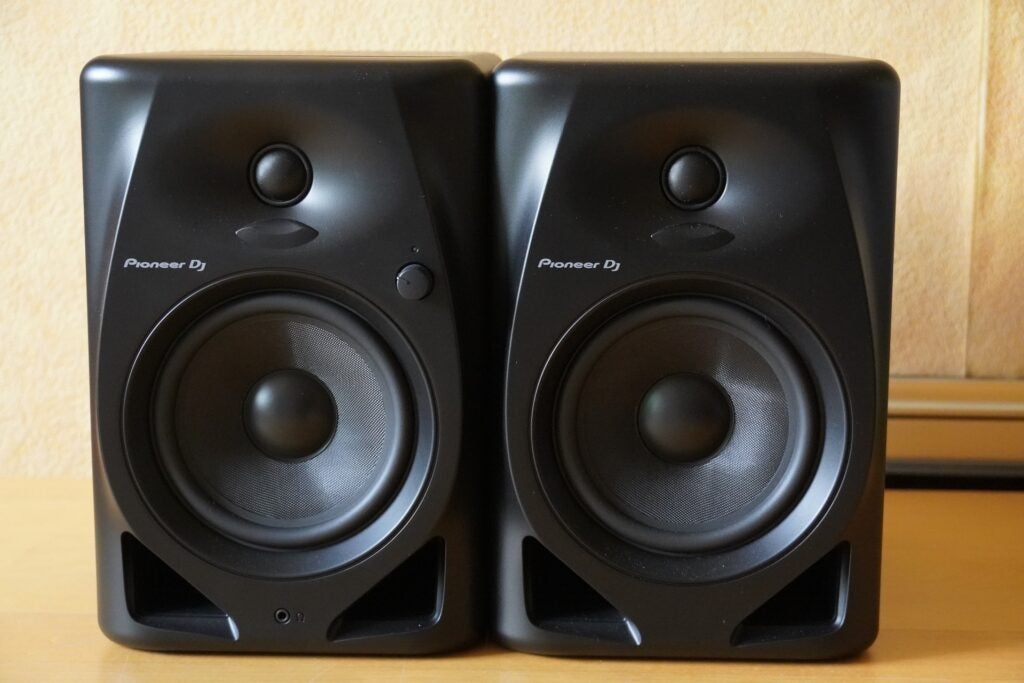
In terms of cable accessories, all you get in the box is the speaker cable, power cable (the one I received was of European specification) and a 3.5mm stereo mini-plug to RCA for connecting to a laptop or mixer. You’ll need to bring your own TRS cables or mini-jacks to open up the speakers to DJ controllers and soundcards.
The EQ switch on the back changes the speaker from DJ mode to Production mode, with the speaker’s DSP settings automatically adjusting to produce the best sound for whatever use you have in mind. If you were to use these speakers for a party, I’d say the DJ mode would make most sense with its warmer characteristics.
Sound Quality
- Switch between warm and neutral EQ modes
- Relatively lacking in bass extension
- Engaging stereo image
The performance you get from the Pioneer DM-50D differs depending on the mode they’re in. DJ mode offers a bigger-sized sound, as well as a more energetic tone with a warmer mid-range and bass response. Production favours clarity, insight and crispness, which you’d expect given its tailored for more critical listening.
Both modes sound very good, with the DJ mode producing a convincing stereo image that’s spacious, detailed and with good depth. The DM-50D live up to Pioneer DJ’s claims of tight but weighty bass; the low-end of the frequency is provided good detail and clarity, while at the other end the speakers deliver bright and expressive treble reproduction.
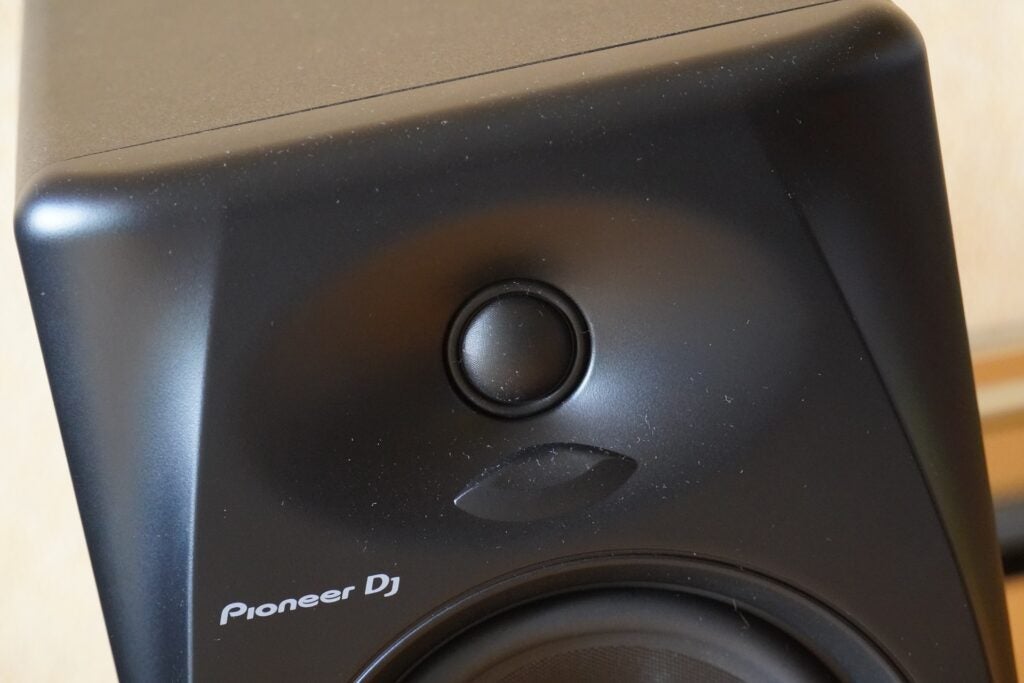
Timing is good across the frequency range, keeping pace with faster and complex tracks without becoming sloppy or muddy. Instruments are described naturally with a warmth in DJ mode. However, in terms of dynamism, this mode isn’t as effective; the DM-50D feel slightly reserved in how they describe the peaks and troughs of a track.
Switch to Production mode and the Pioneer DM-50D change gears easily. This mode loses the warmth of DJ mode and gains more neutrality in the process; clearer, more detailed and incisive, with vocals and instruments described more articulately. There’s also more distinct separation across the frequency range for better timing and balance over what I heard with DJ mode, along with the ability to sift through and relay the details of music I was streaming from Qobuz and Tidal. Vocals in particular sound crisper and cleaner.
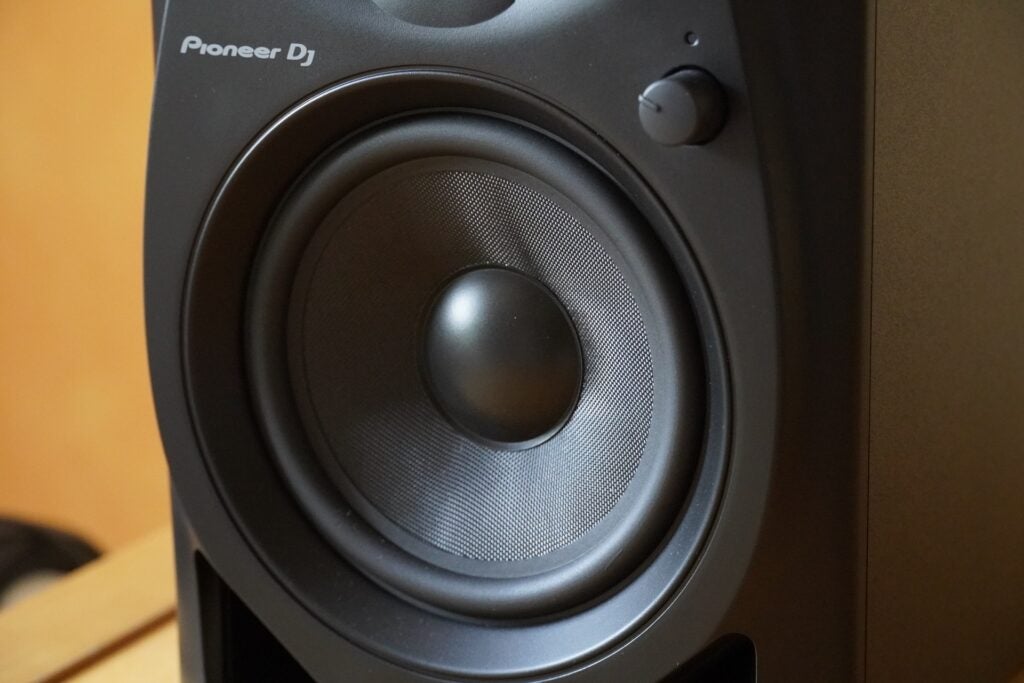
The Production mode offers more of a flourish in terms of dynamism, more faithfully reproducing those highs and lows in music. Unlike the DJ mode, bass takes on a more reined-in quality to its performance, tauter and less weighty.
Across both modes bass is punchily described, but I didn’t get much bass extension to the low-end. If that’s the type of bass performance you’re after in your budding music studio setup, then you won’t find it here.
Latest deals
Should you buy it?
If you’re getting into music production/DJ-ing The main purpose of the DM-50D is to offer a gateway for budding music producers to get started at an affordable price, and the performance makes that easy enough.
You’re after more bass These active speakers take a punchy, taut approach to bass reproduction; if you need more power, weight and extension, however, you’d be best served elsewhere.
Final Thoughts
If you’re someone looking to get into DJ mixing or music production, the Pioneer DM-50D serve as an effective gateway at an affordable price. The switchable EQ delivers two distinct performances – one warmer, the other more neutral – and that gives these speakers a welcome versatility.
Their compact size and grooved duct design aids placement and positioning of the speakers in small spaces, and the sound they offer in their Production mode is a faithful one, while DJ mode is richer and warmer in tone. But the DM-50Ds don’t wring out the biggest bass response for their size. If that’s what you need then I suggest you continue your search for another set of active monitor speakers.
How we test
We test every speaker system we review thoroughly over an extended period of time. We use industry standard tests to compare features properly. We’ll always tell you what we find. We never, ever, accept money to review a product.
Find out more about how we test in our ethics policy.
Tested in both sound modes
FAQs
The DM-50D are a wired speaker and do not support wireless connectivity. There is a wireless version in the DM-50D BT.
Sustainability
Trusted Reviews’ holds the fact that global warming is not a myth as a core value and will continuously endeavour to help protect our planet from harm in its business practices.
As part of this mission, whenever we review a product we send the company a series of questions to help us gauge and make transparent the impact the device has on the environment.
We currently haven’t received answers to the questions on this product, but will update this page the moment we do. You can see a detailed breakdown of the questions we ask and why in our sustainability info page.
Jargon buster
Woofer
A woofer is a type of loudspeaker driver designed to reproduce low frequency (bass) sounds
Tweeter
A tweeter is a type of loudspeaker driver that’s designed to reproduce high frequency (treble) sounds.
Verdict
An active monitor speaker for budding DJs and music producers, the DM-50Ds feature a clever EQ switch, compact design and good reproduction of music, especially in their Production mode. If you’re in need of more bass extension or wireless connectivity, there are other, likely more expensive options, available elsewhere.
Pros
- Switchable EQ modes
- Range of connectivity options
- Good sound from both modes
- Compact design
- Affordable
Cons
- Not suited for bass-heavy productions
- Wireless version is available
Availability
- UKRRP: £199
- USARRP: $199
- EuropeTBC
- CanadaRRP: CA$199
- AustraliaTBC
-
EQ switchChange between sound for warmer DJ presentation or neutral tone for music production on-the-fly -
Class D amplifierFeatures a 96kHz sampling digital signal processor -
Two-way bass reflex speaker3/4-inch tweeter and 5-inch woofer
Introduction
In recent years, the Pioneer brand has been missing from UK stores for a variety of reasons. However, the Pioneer DJ sub-brand is still alive and kicking, even if it’s actually owned by a different parent company (Yokohama-based AlphaTheta).
It perhaps shows that in terms of recognition, the Pioneer name still carries some weight, and the DJ slice of the brand focuses on music production and professional sound systems such as DJ controllers and sound mixers.
The product we have in for review is the DM-50D, a pair of active monitor speakers that can switch between DJ and Production modes to fit your workflow. At £199 they’re an affordable set of speakers for novice producers and budding DJs looking to get into the music production.
Design
- Neat, compact design
- Active speaker approach
- Range of connectivity options
The Pioneer DM-50D come in black or white finishes, and their small and compact form makes it easy to sit them on a desktop surface with dimensions of 262 x 175 247mm (HWD) – note that the left speaker is slightly deeper by 10mm (257mm). With the left speaker weighing 3.9kg and 3.5kg for the right, they’re not too heavy to cart about either.

Build construction is solid. The DM-50D use MDF vinyl laminate material for their cabinet, and a few knocks on the top and side give the reassuring impression of rigidity and inertness. The left speaker forms the active part of the system, featuring a built-in amplifier that removes the need for an external unit. The left speaker is also where the connections can be found, with a headphone output on the front and a 3.5mm stereo mini-jack, TRS jack and RCA connection on the back.

There’s also a terminal for connecting the two speakers by a thin speaker wire (for the wireless version of these speakers, look for the DM-50D-BT online), and there’s also a switch for power alongside another for flicking between the DJ and Production modes.

Back to the front and you’ll find volume control just above the woofer on the left speaker, while towards the bottom are grooved ducts on each speaker. These intend to reduce air friction for tight and punchy bass, even when the speakers are positioned next to a wall. The lack of a rear bass port should offer more freedom in terms of positioning since you won’t have to place the units against a wall to reinforce their bass performance.
Features
- EQ switch for changing speaker’s tone
- Two-way bass reflex system
Inside the cabinet is a new Class D amplifier with a 96kHz sampling DSP that Pioneer DJ says helps to produce a pure and balanced bass sound. The two-way speaker setup features a 5-inch fibre-glass woofer and 0.75-inch soft dome tweeter, the two aligned for clarity across the frequency range.
Updated from the older DM-40 model are the DECO Convex diffusers seated around the tweeter. These are effectively a waveguide to help spread high-frequency sounds from the tweeter in every direction for a wider sweet spot.

In terms of cable accessories, all you get in the box is the speaker cable, power cable (the one I received was of European specification) and a 3.5mm stereo mini-plug to RCA for connecting to a laptop or mixer. You’ll need to bring your own TRS cables or mini-jacks to open up the speakers to DJ controllers and soundcards.
The EQ switch on the back changes the speaker from DJ mode to Production mode, with the speaker’s DSP settings automatically adjusting to produce the best sound for whatever use you have in mind. If you were to use these speakers for a party, I’d say the DJ mode would make most sense with its warmer characteristics.
Sound Quality
- Switch between warm and neutral EQ modes
- Relatively lacking in bass extension
- Engaging stereo image
The performance you get from the Pioneer DM-50D differs depending on the mode they’re in. DJ mode offers a bigger-sized sound, as well as a more energetic tone with a warmer mid-range and bass response. Production favours clarity, insight and crispness, which you’d expect given its tailored for more critical listening.
Both modes sound very good, with the DJ mode producing a convincing stereo image that’s spacious, detailed and with good depth. The DM-50D live up to Pioneer DJ’s claims of tight but weighty bass; the low-end of the frequency is provided good detail and clarity, while at the other end the speakers deliver bright and expressive treble reproduction.

Timing is good across the frequency range, keeping pace with faster and complex tracks without becoming sloppy or muddy. Instruments are described naturally with a warmth in DJ mode. However, in terms of dynamism, this mode isn’t as effective; the DM-50D feel slightly reserved in how they describe the peaks and troughs of a track.
Switch to Production mode and the Pioneer DM-50D change gears easily. This mode loses the warmth of DJ mode and gains more neutrality in the process; clearer, more detailed and incisive, with vocals and instruments described more articulately. There’s also more distinct separation across the frequency range for better timing and balance over what I heard with DJ mode, along with the ability to sift through and relay the details of music I was streaming from Qobuz and Tidal. Vocals in particular sound crisper and cleaner.

The Production mode offers more of a flourish in terms of dynamism, more faithfully reproducing those highs and lows in music. Unlike the DJ mode, bass takes on a more reined-in quality to its performance, tauter and less weighty.
Across both modes bass is punchily described, but I didn’t get much bass extension to the low-end. If that’s the type of bass performance you’re after in your budding music studio setup, then you won’t find it here.
Latest deals
Should you buy it?
If you’re getting into music production/DJ-ing The main purpose of the DM-50D is to offer a gateway for budding music producers to get started at an affordable price, and the performance makes that easy enough.
You’re after more bass These active speakers take a punchy, taut approach to bass reproduction; if you need more power, weight and extension, however, you’d be best served elsewhere.
Final Thoughts
If you’re someone looking to get into DJ mixing or music production, the Pioneer DM-50D serve as an effective gateway at an affordable price. The switchable EQ delivers two distinct performances – one warmer, the other more neutral – and that gives these speakers a welcome versatility.
Their compact size and grooved duct design aids placement and positioning of the speakers in small spaces, and the sound they offer in their Production mode is a faithful one, while DJ mode is richer and warmer in tone. But the DM-50Ds don’t wring out the biggest bass response for their size. If that’s what you need then I suggest you continue your search for another set of active monitor speakers.
How we test
We test every speaker system we review thoroughly over an extended period of time. We use industry standard tests to compare features properly. We’ll always tell you what we find. We never, ever, accept money to review a product.
Find out more about how we test in our ethics policy.
Tested in both sound modes
FAQs
The DM-50D are a wired speaker and do not support wireless connectivity. There is a wireless version in the DM-50D BT.
Sustainability
Trusted Reviews’ holds the fact that global warming is not a myth as a core value and will continuously endeavour to help protect our planet from harm in its business practices.
As part of this mission, whenever we review a product we send the company a series of questions to help us gauge and make transparent the impact the device has on the environment.
We currently haven’t received answers to the questions on this product, but will update this page the moment we do. You can see a detailed breakdown of the questions we ask and why in our sustainability info page.
Jargon buster
Woofer
A woofer is a type of loudspeaker driver designed to reproduce low frequency (bass) sounds
Tweeter
A tweeter is a type of loudspeaker driver that’s designed to reproduce high frequency (treble) sounds.



















